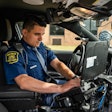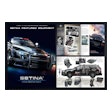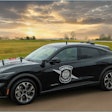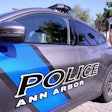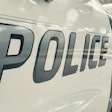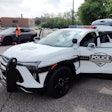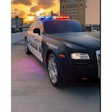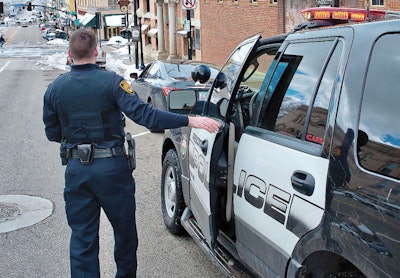 Photo: Mark W. Clark
Photo: Mark W. Clark
You don't have to be on a call for someone to ambush you. In early December 2011, lone police officer Deriek W. Crouse sat in his police vehicle after conducting a traffic stop inside the Virginia Tech campus. A male unrelated to the traffic stop walked up to the vehicle and shot the officer as he sat there, killing him. This is yet another example of an officer being ambushed while on duty. Could this officer have done something to give him a chance to survive this ambush?
In last month's The Winning Edge article, "Urban Counter-ambush Tactics," I discussed how to anticipate and respond to ambushes when arriving on calls in an urban environment. In this related article, I will discuss how to handle ambushes while in your car, including tactics that could have helped this Virginia Tech officer.
Police Vehicles as Targets
Police vehicles are magnets that attract all sorts of people's attention, including those who want to find an officer to kill. Any traffic stop, whether involving motorists or pedestrians, will put officers in the limelight and will expose them to possible ambushes or attacks. Here the concept of "contact and cover" is most important.
The contact officer will do most of the work during the stop. The cover officer will cover. Nothing else. If you are a one-officer car you will do everything, and covering yourself will be the most time-consuming and tiresome job. But don’t compromise.
Never sit in your police car to write a citation or access your MDC during a traffic stop. Use your radio to make inquiries, and do so while in a position of advantage. I usually stand at the right rear of my police vehicle, with the armored passenger side door open as cover. From that vantage point I can maintain an eye on the violator and his vehicle, and I can see anyone approaching me on foot or in a vehicle. Looking up from the citation you're writing every 10 seconds and looking around is a practiced skill. Practice it.
The police vehicle is a big target for a determined sniper, yet many officers act as if they are attached to their police vehicles by an invisible umbilical cord. Police vehicles do not make good cover unless you are fortunate enough to have the engine block between you and the shooter. A moving target is harder to hit, so if you’re being fired on and cannot get out of your vehicle, keep moving and accelerate away from the location, and turn away from the street you're on (into another street or a driveway) in order to reduce the size of the kill zone.
If you are in a residential neighborhood and you are being shot at by an unseen shooter, immediately turn left or right into a driveway and drive all the way up as far into the location as you can. If there are no driveways, drive over the curb toward the space between two houses. Immediately exit the police vehicle and try to locate the shooter.
At this point, breathe. Don't panic.
The last thing an officer should ever do is scream incoherently for help on the radio. This will only bring other officers into the kill zone, without any helpful information. Do request assistance or help, but ask responding officers to set up a large containment of the area until you can ascertain the suspect's location. If you know the direction the shots came from, have officers respond to your location from the opposite direction on foot via backyards or alleys. This is important: Have them stay off the street.
If you are being fired upon from the upper floor or the rooftop of a multi-story building, hit the accelerator and drive toward the building. This will reduce the angle of the kill zone because the shooter will have to reveal more and more of himself as he tries to keep the police car in his sights below his location. If necessary, drive the police car into the building’s lobby. In this situation, have responding officers take control of the rooftops of the adjoining buildings and contain the building where the suspect is located.
Unless the suspect presents an immediate threat to others, this situation should be handled by trained SWAT personnel. Officers should contain the area and begin to get intelligence information, building plans, etc., that will assist SWAT personnel with their mission.
Emergency Lights
Whenever possible, turn off your police vehicle emergency lights immediately upon arrival at or near a call location, especially at night. Several police vehicles parked at a call location with their emergency lights flashing red/blue hues into the darkness is something you should only ever see on cop shows on TV.
In reality, activated emergency lights at a call location only serve to attract unnecessary people to your call location like moths are attracted to a light bulb. Additionally, emergency lights in modern police vehicles are very bright, and these super-bright emergency LED lights deprive you of your night vision as well as make your police car an even more visible target.[PAGEBREAK]If you need to leave some indication of your location at night to responding officers, leave only your vehicle’s parking lights on. Nothing works to blind your fellow responding officers more than the flashing emergency lights of your police vehicle (whether all of them or just the ambers) as they turn the corner behind your unit. It will take them several minutes to recover their night vision after they walk past your vehicle. Avoid all of these problems by just turning the bright lights off.
Vehicle Placement
Patrol driving should be conducted with an eye on the possibility that an ambush can happen at any given traffic light. Keep the following tactics in mind and also share them with your family members.
Never stop your vehicle door-to-door with the vehicle next to you. A good vehicle position is with your windshield parallel to the other vehicle's rear bumper. This position will allow you or your partner to open your vehicle's doors without interference in case a quick exit is necessary.
While stopped at traffic lights, keep enough distance between you and the vehicle in front of you to allow you to go around it in case you are fired upon. A good position will allow you to see the vehicle’s rear tires at the point where they contact the pavement.
Try to avoid using the drive-thru option at fast food restaurants. This is a perfect location for an ambush of police officers, and in many driveways there isn't enough space for you to open your vehicle's doors. Fast food restaurant driveways are a preferred location for carjackings, armed robberies, and also a favorite place for panhandlers to operate.
Cover Fire
First let us make sure we define the term "cover fire" for law enforcement purposes, as it differs from the military term. My agency defines cover fire as "controlled and deliberate fire directed at a life-endangering threat, where an officer believes the threat to be located. Cover fire should be used when exposed to a life-endangering threat to protect others and stop the threat. Cover fire should only be deployed when other options are not feasible."
If you are being fired upon by a sniper and find yourself without adequate cover, you can and should fire at the location you reasonably believe the sniper fire is coming from, which will allow partner officers to quickly move to cover. Fire two or three rounds directly at the source of the sniper fire in order to keep the suspect's head down, and then move to another location and seek cover. Remember, the move to cover should last between 3 and 5 seconds as it takes that long for a shooter to see and acquire a moving target. It is a bad idea to move quickly to another location with a weapon that is out of battery for one never knows if there are additional suspects in the area.
Communication between officers in such a situation is key. If you have a partner on scene, one of you should provide cover fire while the other moves to cover. Once behind cover, the first officer can provide cover fire while the second officer moves to cover. You should both be using different cover locations in order to make the sniper shift his or her weapon position to engage each officer. It will also allow at least one of you to see the source of the threat and to engage it.
This tactic should keep the sniper busy trying to avoid gunfire and will allow additional officers to position themselves in order to engage him or her. Although you and your partner should use separate cover, you should be in direct line of sight with each other to maintain communication. The most important thing for you to remember if you are attacked by a sniper is to react, move, and fight back.
Each agency has policies on the use of deadly force, and officers should abide by those policies and what is legally permissible within their respective jurisdictions.
Extra Ammo
My agency has recently trained all of its personnel in Multi-Assault Counter Terrorism Action Capabilities (MACTAC). These tactics were developed as a result of the Mumbai terrorist attack against that city's security forces and infrastructure. One of the things we discovered during this training was that engaging heavily armed active shooters using cover fire and movement will require lots and lots of ammunition.
The average police officer in America carries the ammunition held by his or her pistol and spare magazines in belt pouches, and maybe an extra box. Let's face it: most cops are cheapskates, and many believe that unless the agency pays for it, they don't need it. Spending some of your own money to ensure you have an adequate supply of ammunition to engage multiple armed suspects is something you and every officer must think about. You don't want to run out and become part of the problem, hiding from gunfire with empty weapons.
It is, therefore, extremely important for officers working the streets of our cities and the roads and highways of our nation to remain alert, remain unpredictable, and do the unexpected on every call and on every stop. I hope this article has helped you toward that goal.
André Belotto is a 24-year veteran of the Los Angeles Police Department, and has held the rank of sergeant since 1997. He currently supervises patrol officers in the field. He is also the Terrorism Liaison Officer for his station and has recently supervised the training of his agency's personnel on Multi Assault Counter Terrorist Action Capabilities (MACTAC).
Related:









